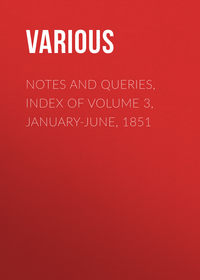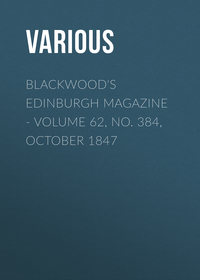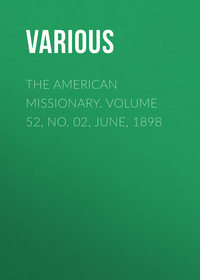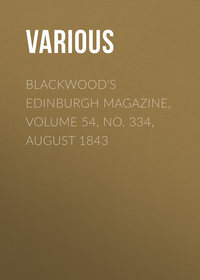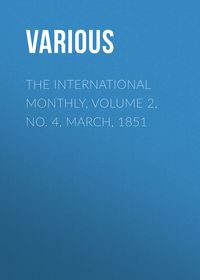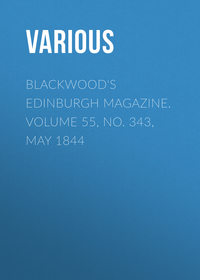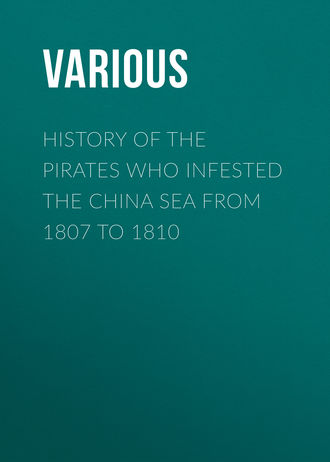 полная версия
полная версияHistory of the Pirates Who Infested the China Sea From 1807 to 1810
1809.
About this time, when the red squadron was assembled in Kwang chow wan, or the Bay of Kwang chow, Tsuen mow sun went to attack them; but he was not strong enough. The wife of Ching yĭh remained quiet; but she ordered Chang paou to make an attack on the front of our line with ten vessels, and Leang po paou to come from behind. Our commander fought in the van and in the rear, and made a dreadful slaughter; but there came suddenly two other pirates, Hëang shang url, and Suh puh king, who surrounded and attacked our commander on all sides. Our squadron was scattered, thrown into disorder, and consequently cut to pieces; there was a(11 v.) noise which rent the sky; every man fought in his own defence, and scarcely a hundred remained together. The squadron of Ching yĭh overpowered us by numbers; our commander was not able to protect his lines, they were broken, and we lost fourteen vessels.
1809.
Our men of war, escorting some merchant vessels, in the fourth moon of the same year, happened to meet the pirate nicknamed The Jewel of the whole crew, cruizing at sea near a place called Tang pae keŏ, outside of Tsëaou mun. The traders became exceedingly frightened, but our commander said: "This not being the red flag, we are a match for them, therefore we will attack and conquer them." Then ensued a battle; they attacked each other with guns and stones, and many people were killed and wounded. The fighting ceased towards the evening, and began again next(12 r.) morning. The pirates and the men of war were very close to each other, and they boasted mutually about their strength and valour. It was a very hard fight; the sound of cannon and the cries of the combatants were heard some le55 distant. The traders remained at some distance; they saw the pirates mixing gun-powder in their beverage, – they looked instantly red about the face and the eyes, and then fought desperately56 This fighting continued three days and nights incessantly; at last becoming tired on both sides, they separated.
1809.
On the eighth day of the fifth moon the pirates left their lurking place, attacked Kan chuh han, and burned and plundered the houses. On the tenth they burned and plundered Kew këang,(12 v.) Sha kow, and the whole sea-coast; they then turned about to Këe chow, went on shore, and carried away fifty-three women by force. They went to sea again the following day, burned and plundered on their way about one hundred houses in Sin hwy and Shang sha, and took about a hundred persons of both sexes prisoners.
1809.
On the sixth moon, the admiral Ting kwei heu went to sea. Wishing to sail eastward, but falling in with heavy rains for some days, he stopped near Kwei këa mun,57 and engaged in settling concerning his ballast. On the eighth day of this moon, Chang paou, availing himself of the bad weather, explored the station in a small boat and passed the place. Ting kwei was right in thinking that the pirates would not undertake any thing during these heavy rains; but he was careless regarding what might happen after it. Indeed, as the weather cleared up on the morning of the ninth, Chang paou appeared suddenly before the admiral, and formed a line(13 r.) of two hundred vessels. Ting kwei having no sails ready, and all the ships being at anchor, could by no means escape the pirates. The officers, being afraid of the large number of the enemy, stood pale with apprehension near the flagstaff, unwilling to fight. The admiral spoke to them in a very firm manner, and said: "By your fathers and mothers, by your wives and children, do your duty; fight and destroy these robbers. Every man must die: but should we be so happy as to escape, our rewards from government will be immense. Should we fall in the defence of our country, think that the whole force of the empire will be roused, and they will try by all means to destroy these banditti." They now all united together in a furious attack, and sustained(13 v.) it for a long time: Ting kwei fired his great guns,58 and wounding the ringleader, nicknamed The Jewel of the whole crew, he fell down dead.
1809.
The pirates were now at a loss how to proceed; but they received succour, while the force of our commander diminished every moment. About noon Paou drew nearer to the vessel of Ting kwei, attacked her with small arms, and sustained a great loss. But Leang po paou suddenly boarded the vessel, and the crew was thrown into disorder. Ting kwei seeing that he was unable to withstand, committed suicide; while an immense number of his men perished in the sea, and twenty-five vessels were lost.
1809.
Our former deputy-governor Pih ling was about this time removed from his situation in the three Këang to become governor-general of the two Kwang.59 People said, now that Pih(14 r.) comes we shall not be overpowered by the pirates. Old men crowded about the gates of the public offices to make enquiries; the government officers appeared frightened and held consultations day and night, and the soldiers were ordered by a public placard to hold themselves ready to march. "Since the death of Wang pëaou," it was said, "all commanders were unfortunate. Last year Kwŏ lang lin was killed in the battle at Ma chow; Tsuen mow sun was unlucky at Gaou kow, Url lin ran away like a coward at Lang pae, and now Ting kwei has(14 v.) again been routed at Kwei këa. If the valiant men let their spirits droop, and the soldiers themselves become frightened at these repeated defeats, the pirates will certainly overpower us at last; we can really not look for any assistance to destroy them. We must try to cut off all provisions, and starve them." In consequence of this, all vessels were ordered to remain, or to return into harbour, that the pirates might not have any opportunity to plunder, and thus be destroyed by famine. The government officers being very vigilant about this regulation, the pirates were not able to get provisions for some months; they became at last tired of it, and resolved to go into the river itself.60
1809.
The pirates came now into the river by three different passages.61 The wife of Ching yĭh plundered about Sin hwy, Chang paou about Tung kwan,62 and O po tae about Fan yu63 and Shun tih, and all other smaller places connected(15 r.) with Shun tih; they were together explored by the pirates, who guarded the passage from Fan to Shun.
1809.
On the first day of the seventh moon, O po tae came with about a hundred vessels and burnt the custom-house of Tsze ne. On the second day he divided his squadron into four divisions, extending to Peih këang, Wei yung, Lin yo, Shĭh peih, and other villages. The Chang lung division64 surrounded the whole country from Ta wang yin to Shwy sse ying. The Ta chow, or large-vessel division, blockaded Ke kung shĭh, which is below the custom-house of Tsze ne. The pirates sent to the village Tsze ne, demanding ten thousand pieces of money65 as tribute; and of San shen, a small village near Tsze ne on the right side, they demanded two thousand.(15 v.) The villagers differed in opinion; one portion would have granted the tribute, another would not. That part who wished to pay the tribute said: "The pirates are very strong; it is better to submit ourselves now, and to give the tribute that we may get rid of them for awhile; we may then with leisure think on means of averting any misfortunes which may befall us. Our villages are near the coast, we shall be surrounded and compelled to do what they like, for no passage is open by which we can retire. How can we, under such circumstances, be confident and rely on our own strength?"
1809.
The other part, who would not grant the tribute, said: "The pirates will never be satisfied; if we give them the tribute now, we shall not be able to pay it on another day. If they should make extortions a second time, when should we get money to comply with their demands? Why should we not rather spend the two thousand pieces of money to encourage government officers and the people? If we(16 r.) fight and happen to be victorious, our place will be highly esteemed; but if, what heaven may prevent, we should be unlucky, we shall be everywhere highly spoken of." The day drew to its end, and they could not agree in what they should determine on, when one villager arose and said: "The banditti will repeatedly visit us, and then it will be impossible to pay the tribute; we must fight."
1809.
As soon as it was resolved to resist the demands of the pirates, weapons were prepared, and all able men, from sixteen years and upwards to sixty, were summoned to appear with their arms near the palisades. They kept quiet the whole of the second day, and proceeded not to fighting; but the people were much disturbed, and did not sleep the whole night. On the following day they armed and posted themselves on the sea-coast. The pirates, seeing that the(16 v.) villagers would not pay the tribute, became enraged, and made a severe attack during the night; but they could not pass the ditch before the village. On the morning of the fourth, O po tae headed his men, forced the ditch, took the provisions, and killed the cattle. The pirates in great numbers went on shore; but the villagers made such a vigorous resistance that they began to withdraw. O po tae therefore surrounded the village on both sides, and the pirates took possession of the mountain in the rear; they then threw the frightened villagers into disorder, pursued them, and killed about eighty. After this the pirates proceeded with their van to the sea-shore, without encountering any resistance from the front. The villagers were from the beginning very much alarmed for their(17 r.) wives and daughters; they collected them in the temple and shut it up. But the pirates being victorious, opened the temple, and carried the women by force all away on board ship. One pirate set off with two very fine women; a villager, on seeing this, pursued after and killed him in a hidden place. He then took the women and carried them safe through the water, – this was a servant. A great number of the pirates were killed and wounded, and the villagers lost about two thousand persons. What a cruel misfortune! it is hard indeed only to relate it.
1809.
On the third day of the moon the people of Ta ma chow, hearing that the pirates were coming near, ran away. The pirates plundered all that was left behind, clothes, cattle, and provisions. On the sixth day they came so far as(17 v.) Ping chow and San shan. On the eighth they retired to Shaou wan, made an attack upon it on the ninth, but could not take it. On the tenth they ascended the river with the tide, went on shore, and burned Wei shih tun. On the eleventh day they came to our village, but retired again at night on command. On the twelfth they attacked Hwang yung, and left it again on the thirteenth. They retired on the fourteenth, and stopped at Nan pae. On the fifteenth they sailed out of the Bocca Tigris,66 and on the twenty-sixth attacked the ships which bring the tribute from Siam,67 but were not strong enough to capture them. On the twenty-ninth they attacked the places Tung(18 r.) hwan and Too shin, and killed nearly a thousand men.
1809.
The pirates tried many stratagems and frauds to get into the villages. One came as a country gentleman to take charge of the government guns; another came in a government vessel as if to assist the village; after which they on a sudden attacked and plundered all, when people were not aware of them. One pirate went round as a pedlar, to see and hear all, and to explore every place. The country people became therefore at last enraged, and were in future always on their guard. If they found any foreigner, they took him for a pirate and killed him. So came once a government officer on shore to buy rice; but the inhabitants thought he was a pirate and killed him. There was every where a degree of confusion, which it is impossible to explain.
1809.
On the sixteenth day of the seventh moon, the pirates attacked a village near Tung kwan.(18 v.) The villagers knowing what would happen, made fences and palisades, and obstructed the passage with large guns. Armed with lances and targets they hid themselves in a secret place, and selected ten men only to oppose the pirates. The pirates seeing that there were so few people, went on shore to pursue them. As soon as they came near the ambuscade the guns were fired; the pirates became alarmed and dared not advance farther. Not being hurt by the fire, they again advanced; but three pirates presuming that there was an ambush, thought of retreating, and being very hard pressed by the enemy, they gave a sign to their comrades to come on shore. The ten villagers then retired near the ambush, and when the pirates pursued them, about a hundred were killed by their guns, and the whole force of the banditti was brought into disorder. The villagers pursued them killing(19 r.) many; those also who had been taken alive were afterwards beheaded. They captured one small and two large vessels.68
1809.
On the eighteenth day of the eighth moon the wife of Ching yĭh came with about five hundred vessels from Tung kwan and Sin hwy, and caused great commotion in the town Shun tih, Hëang shan, and the neighbouring places. The squadron stopped at Tan chow, and on the twentieth Chang pao was ordered to attack Shaou ting with three hundred vessels. He carried away about four hundred people, both male and female; he came also to the palisades of our village, but could not penetrate inside. The twenty-first he came to Lin tow, and the twenty-second to Kan shin; he made an attack, but could not overpower the place; he then returned to Pwan pëen jow, and lay before its fence. The inhabitants of Chow po chin,(19 v.) knowing that the pirates would make an attack, assembled behind the wall to oppose them. The pirates fired their guns and wounded some, when the villagers ran away. The pirates then went on shore, but the villagers crowded together and fired on them; the pirates cast themselves on the ground, and the shots passed over their heads without doing any harm. Before the gunners could again load, the pirates sprang up and put them to death. Out of the three thousand men who were in the battle, five hundred were carried away by the pirates. One of the most daring pirates, bearing the flag, was killed by the musket of a villager; a second pirate then took the flag, and he also was killed. The pirates now pressed against the wall and advanced. There was also a foreign pirate69 engaged in the battle with a(20 r.) fowling-piece. The pirates assembled in great numbers to cut the wall with their halberts, but they were disappointed on seeing they could not attain their object in such a manner. The pirates lost their hold, fell down, and were killed. The engagement now became general, and great numbers were killed and wounded on both sides. The villagers at last were driven from their fortifications, and the pirates pursued them to Mih ke, or the rocks about Mih, where they were hindered from going farther by foggy weather; they retired and burned about twenty houses, with all they contained. On the following day the pirates appeared again on the shore, but the inhabitants made a vigorous resistance, and being driven back, they retired to the citadel Chih hwa, where a thousand of them fought so hard that the pirates withdrew. It(20 v.) was reported that ten of them were killed, and that the villagers lost eight men. On the twenty-third the wife of Ching yĭh ordered O po tae to go up the river with about eighty vessels: he stopped at Show ke and Kung shih. On the twenty-fourth Chang paou and Po tae divided this district between themselves, and robbed and burned all. Pao had to plunder the north part to Fo shin; he carried away about ten thousand stones of rice,70 and burned down about thirty houses; on the twenty-fifth he went to Se shin. O po tae came and burnt San heung keih; he then plundered Hwang yung, and came to Këen ke, but did not make an attack against it. He afterwards returned and laid waste Cha yung.
1809. (21 r.)
On the twenty-sixth Chang paou went up the river to Nan hae71 and Lan shĭh. In the harbour of the place were six rice vessels; and as soon as Paou was in Lan shĭh he made preparations to capture these vessels. The military officer, seeing that the pirates were numerous, remained however on his station, for the instant he would have moved, Paou would have attacked and captured him. Paou proceeded then against the village itself; but the officer Ho shaou yuen headed the inhabitants, and made some resistance. The pirates, nevertheless, mounted the banks; and the villagers seeing their strength, did not stay to fight – they became frightened and ran away: all the others ran away without making any resistance: Ho shaou yuen alone opposed the banditti with a handful of people; but he at last fell fighting, and the pirates burnt(21 v.) four hundred shops and houses, and killed about ten persons. After the pirates had retired, the inhabitants held in high esteem the excellent behaviour of Ho shaou yuen; they erected him a temple, and the deputy-governor Han fung performed sacrifices to his memory.
1809.
Shaou yuen was commanding officer in the citadel of Lan shih; he was of an active spirit, and erected strong fences. Before the pirates arrived, this was his daily discourse when he spoke to the people: "I know that I shall be glorified this year by my death." Half the year being already passed, it could not be seen how this prophecy was to be fulfilled. When the pirates came, he encouraged the citizens to oppose them vigorously; he himself girded on his sword and brandished his spear, and was the most forward in the battle. He killed many persons; but his strength failed him at last, and he was himself killed by the pirates. The villagers were greatly moved by his excellent behaviour; they erected him a temple, and said prayers before his effigy. It was then known what he meant, that "he would be glorified in the course of the year." Now that twenty years are passed, they even honour him by exhibiting fire-works. I thought it proper to subjoin this remark to my history.72
1809.
On the twenty-seventh, Lin sun mustered about forty vessels, and went out to fight with the pirates in order to protect the water passage. He remained at Kin kang (which is near Shaou wan hae), hid himself westerly of that place the whole day, and removed then to Tsze(22 r.) ne. Chang paou ordered his vessels to remove to Shaou ting, and his men to go on shore in the night-time. Sun, seeing with sorrow that the pirates were so numerous, and that he could not make any effectual resistance, ran away eastwards and hid himself at Peih keang. At daylight the following morning the pirates sailed to Tsze ne to attack our commander, but not finding him, they stopped at Shaou ting; for this being the time when the autumnal winds begin to blow, they were afraid of them, and made preparations to retire. But we shall soon find the different flags returning to the high sea to fight both with extraordinary courage and great ferocity.73
1809. (22 v.)
On the twenty-ninth they returned to plunder Kan shin; they went into the river with small vessels, and the inhabitants opposing them, wounded two pirates, which all the pirates resented. They next came with large vessels, surrounded the village, and made preparations to mount the narrow passes. The inhabitants remained within the intrenchments, and dared not come forward. The pirates then divided their force according to the various passes, and made an attack. The inhabitants prepared themselves to make a strong resistance near the entrance from the sea on the east side of the fence; but the pirates stormed the fence, planted their flag on the shore, and then the whole squadron followed. The inhabitants fought bravely, and made a dreadful slaughter when the pirates crossed the entrance at Lin tow. The boxing-master, Wei tang chow, made a vigorous resistance, and killed about ten pirates. The pirates then began to withdraw, but Chang paou himself headed the battle, which lasted very long. The inhabitants were not strong enough. Wei tang was surrounded by the pirates;(24 r.) nevertheless that his wife fought valiantly by his side. On seeing that they were surrounded and exhausted, the father of the lady74 rushed forward and killed some pirates. The pirates then retired in opposite directions, in order to surround their opponents in such a manner that they might not escape, and could be killed without being able to make any resistance; and thus it happened, the wife of Wei tang being slain with the others.
The pirates now pursued the inhabitants of the place, who cut the bridge and retired to the neighbouring hills. The pirates swam through the water and attacked the inhabitants, who were unable to escape. The whole force of the pirates being now on shore, the inhabitants suffered a severe loss, – it is supposed about a hundred of them were killed; the loss of the pirates also was considerable.
1809. (23 v.)
The pirates went in four divisions to plunder; they took here an immense quantity of clothes and other goods, and carried away one thousand one hundred and forty captives of both sexes. They set on fire about ten houses; the flames could not be extinguished for some days; in the whole village you could not hear the cry of a dog or a hen. The other inhabitants retired far from the village, or hid themselves in the fields. In the paddy fields about a hundred women were hidden, but the pirates on hearing a child crying, went to the place and carried them away. Mei ying, the wife of Ke choo yang, was very beautiful, and a pirate being about to seize her by the head, she abused him exceedingly. The pirate bound her to the yard-arm; but on abusing him yet more, the pirate dragged her down and broke two of her teeth, which filled her mouth and jaws with blood. The pirate sprang up again to bind her. Ying allowed him to approach, but as soon as he came near her, she laid hold of his garments with her bleeding mouth, and threw both him and herself into the river, where they were drowned, The remaining captives of both sexes were after some months liberated, on having paid a ransom of fifteen thousand leang or ounces of silver.
1809.
Travelling once to Pwan pëen jow I was affected by the virtuous behaviour of Mei ying, and all generous men will, as I suppose, be moved by the same feelings. I therefore composed a song, mourning her fate:
Chėn kė kīn seāou hëĕ,Chúy szē chūng soó mëèn.Tāng shĕ shwăy fàn leĭh,Yĕw nèu tăh nāng tsūy;Tsëĕn hĕuĕ yīng kwáng nëĕ,75Yuĕn keă yuĕn shwăy weī.Shwūy hwăn pō shàng heà,Yīng lëe sháng pèi hwūy.1809.
Cease fighting now for awhile!Let us call back the flowing waves!Who opposed the enemy in time?A single wife could overpower him.(24 v.)Streaming with blood, she grasped the mad offspring of guilt,She held fast the man and threw him into the meandering stream.The spirit of the water, wandering up and down on the waves,Was astonished at the virtue of Ying.My song is at an end!Waves meet each other continually.I see the water green as mountain Peih,But the brilliant fire returns no more!76How long did we mourn and cry!77BOOK SECOND
1809. (1 r.)
On the thirteenth day of the ninth moon our Admiral Tsuen mow sun mustered about eighty vessels to go to Shaou wan, and obstruct the passage. The pirates heard of these preparations, and on the night of the fourteenth every vessel of the different flags was ordered to go to Shaou wan. Their order was, that being within ten le from the place, they should stop and prepare themselves to begin the battle when it was dark. From the first night watch the cannon began to fire, and only ceased with(1 v.) daylight. At the end of the day the cannon were again roaring without any intermission, and the country people mounted on the green Lo shang, to look at the progress of the fight. They saw the wrecks of vessels floating on the sea, the waves were rolling, the bullets flying, and the cries of dying people mounted to the skies. The vallies re-echoed the noise; beasts and birds78 started alarmed, and found no place where they might repose themselves. The vessels were thrown into disorder, and our army was pressed down by the overpowering force of the enemy. Our commander lost four vessels, but the palisade before the village could not be taken, by which means it was protected against pillage. Our admiral said, "Since I cannot conquer these wicked pirates, I will blow myself up." In this manner the(2 r.) admiral and many other officers met their death.



